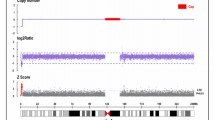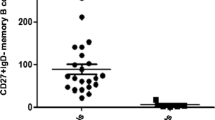Abstract
X-linked agammaglobulinemia (XLA) is characterized by low levels of B-lymphocytes with early-onset, recurrent, microbial infections occasionally causing neurological symptoms. We observed an atypical clinical course of XLA, complicated since early childhood with neurological impairment, progressive sensorineural deafness, and dystonia in six boys of four unrelated families. The neurologic symptoms suggested the diagnosis of Mohr–Tranebjaerg syndrome, caused by mutations in the TIMM8A gene, previously known as DDP1, and located centromerically of BTK. Deafness dystonia peptide (DDP1) participates in neurological development and is a part of the mitochondrial protein import pathway. Mutation analysis of the BTK gene revealed gross deletions of different lengths in all patients, in one case extending approximately 196 kb, including the genes TIMM8A, TAF7L, and DRP2. The most prominent clinical findings of this contiguous deletion syndrome are the combination of immunodeficiency and sensorineural deafness, which were present in all affected boys. The severity of symptoms, however, did not correlate with the extent of the deletion.


Similar content being viewed by others
References
Bruton OC. Agammaglobulinemia. Pediatrics. 1952;9 (6):722–8.
Rich R, Fleisher TA. Clinical immunology, principles and practice. St. Louis, MO: Mosby; 2001.
Ochs HD, Smith CI. X-linked agammaglobulinemia. A clinical and molecular analysis. Medicine (Baltimore). 1996;75 (6):287–99.
Online Mendelian Inheritance in Man, OMIM (TM), Johns Hopkins University, Baltimore, MD, MIM Number: 300300, date last edited: 4/11/2007. http://www.ncbi.nlm.nih.gov/omim/. Cited May 3, 2007.
Quartier P, Debre M, De Blic J, de Sauverzac R, Sayegh N, Jabado N, et al. Early and prolonged intravenous immunoglobulin replacement therapy in childhood agammaglobulinemia: a retrospective survey of 31 patients. J Pediatr. 1999;134 (5):589–96.
Vetrie D, Vorechovsky I, Sideras P, Holland J, Davies A, Flinter F, et al. The gene involved in X-linked agammaglobulinaemia is a member of the src family of protein-tyrosine kinases. Nature. 1993;361 (6409):226–33.
Tsukada S, Saffran DC, Rawlings DJ, Parolini O, Allen RC, Klisak I, et al. Deficient expression of a B cell cytoplasmic tyrosine kinase in human X-linked agammaglobulinemia. Cell. 1993;72 (2):279–90.
Smith CI, Baskin B, Humire-Greiff P, Zhou JN, Olsson PG, Maniar HS, et al. Expression of Bruton’s agammaglobulinemia tyrosine kinase gene, BTK, is selectively down-regulated in T lymphocytes and plasma cells. J Immunol. 1994;152 (2):557–65.
Valiaho J, Smith CI, Vihinen M. BTKbase: the mutation database for X-linked agammaglobulinemia. Hum Mutat. 2006;27 (12):1209–17.
Lindvall JM, Blomberg KE, Valiaho J, Vargas L, Heinonen JE, Berglof A, et al. Bruton’s tyrosine kinase: cell biology, sequence conservation, mutation spectrum, siRNA modifications, and expression profiling. Immunol Rev. 2005;203:200–15.
Vorechovsky I, Vetrie D, Holland J, Bentley DR, Thomas K, Zhou JN, et al. Isolation of cosmid and cDNA clones in the region surrounding the BTK gene at Xq21.3-q22. Genomics. 1994;21 (3):517–24.
Jin H, May M, Tranebjaerg L, Kendall E, Fontan G, Jackson J, et al. A novel X-linked gene, DDP, shows mutations in families with deafness (DFN-1), dystonia, mental deficiency and blindness. Nat Genet. 1996;14 (2):177–80.
Tranebjaerg L, Hamel BC, Gabreels FJ, Renier WO, Van Ghelue M. A de novo missense mutation in a critical domain of the X-linked DDP gene causes the typical deafness-dystonia-optic atrophy syndrome. Eur J Hum Genet. 2000;8 (6):464–7.
Mohr J, Mageroy K. Sex-linked deafness of a possibly new type. Acta Genet Stat Med. 1960;10:54–62.
Tranebjaerg L, Lou H, Andresen J. New X-linked syndrome with apraxia, ataxia, and mental deficiency: clinical, cytogenetic and neuropsychological studies in two Danish families. Am J Med Genet. 1992;43 (1–2):498–504.
Tranebjaerg L, Schwartz C, Eriksen H, Andreasson S, Ponjavic V, Dahl A, et al. A new X linked recessive deafness syndrome with blindness, dystonia, fractures, and mental deficiency is linked to Xq22. J Med Genet. 1995;32 (4):257–63.
Jin H, Kendall E, Freeman TC, Roberts RG, Vetrie DL. The human family of Deafness/Dystonia peptide (DDP) related mitochondrial import proteins. Genomics. 1999;61 (3):259–67.
Jyonouchi H, Geng L, Toruner GA, Vinekar K, Feng D, Fitzgerald-Bocarsly P. Monozygous twins with a microdeletion syndrome involving BTK, DDP1, and two other genes; evidence of intact dendritic cell development and TLR responses. Eur J Pediatr 2007 (in press).
Vorechovsky I, Vihinen M, de Saint Basile G, Honsova S, Hammarstrom L, Muller S, et al. DNA-based mutation analysis of Bruton’s tyrosine kinase gene in patients with X-linked agammaglobulinaemia. Hum Mol Genet. 1995;4 (1):51–8.
Siebert PD, Chenchik A, Kellogg DE, Lukyanov KA, Lukyanov SA. An improved PCR method for walking in uncloned genomic DNA. Nucleic Acids Res. 1995;23 (6):1087–8.
Fox JE, Reynolds CC, Boyles JK. Studying the platelet cytoskeleton in Triton X-100 lysates. Methods Enzymol. 1992;215:42–58.
Makinen MW, Lee CP. Biochemical studies of skeletal muscle mitochondria. I. Microanalysis of cytochrome content, oxidative and phosphorylative activities of mammalian skeletal muscle mitochondria. Arch Biochem Biophys. 1968;126 (1):75–82.
Rustin P, Lebidois J, Chretien D, Bourgeron T, Piechaud JF, Rotig A, et al. Endomyocardial biopsies for early detection of mitochondrial disorders in hypertrophic cardiomyopathies. J Pediatr. 1994;124 (2):224–8.
Roesch K, Curran SP, Tranebjaerg L, Koehler CM. Human deafness dystonia syndrome is caused by a defect in assembly of the DDP1/TIMM8a-TIMM13 complex. Hum Mol Genet. 2002;11 (5):477–86.
Roesch K, Hynds PJ, Varga R, Tranebjaerg L, Koehler CM. The calcium-binding aspartate/glutamate carriers, citrin and aralar1, are new substrates for the DDP1/TIMM8a-TIMM13 complex. Hum Mol Genet. 2004;13 (18):2101–11.
Richter D, Conley ME, Rohrer J, Myers LA, Zahradka K, Kelecic J, et al. A contiguous deletion syndrome of X-linked agammaglobulinemia and sensorineural deafness. Pediatr Allergy Immunol. 2001;12 (2):107–11.
Conley ME, Notarangelo LD, Etzioni A. Diagnostic criteria for primary immunodeficiencies. Representing PAGID (Pan-American Group for Immunodeficiency) and ESID (European Society for Immunodeficiencies). Clin Immunol. 1999;93 (3):190–7.
Koehler CM, Leuenberger D, Merchant S, Renold A, Junne T, Schatz G. Human deafness dystonia syndrome is a mitochondrial disease. Proc Natl Acad Sci U S A. 1999;96 (5):2141–6.
Orstavik KH, Orstavik RE, Eiklid K, Tranebjaerg L. Inheritance of skewed X chromosome inactivation in a large family with an X-linked recessive deafness syndrome. Am J Med Genet. 1996;64 (1):31–4.
Wallace DC, Murdock DG. Mitochondria and dystonia: the movement disorder connection. Proc Natl Acad Sci USA. 1999;96 (5):1817–9.
Tranebjaerg L, Jensen PK, van Ghelue M. X-linked recessive deafness-dystonia syndrome (Mohr-Tranebjaerg syndrome). Adv Otorhinolaryngol. 2000;56:176–80.
Ujike H, Tanabe Y, Takehisa Y, Hayabara T, Kuroda S. A family with X-linked dystonia-deafness syndrome with a novel mutation of the DDP gene. Arch Neurol. 2001;58 (6):1004–7.
Pointud JC, Mengus G, Brancorsini S, Monaco L, Parvinen M, Sassone-Corsi P, et al. The intracellular localisation of TAF7L, a paralogue of transcription factor TFIID subunit TAF7, is developmentally regulated during male germ-cell differentiation. J Cell Sci. 2003;116 (Pt 9):1847–58.
Cheng Y, Buffone MG, Kouadio M, Goodheart M, Page DC, Gerton GL, et al. Abnormal sperm in mice lacking the Taf7l gene. Mol Cell Biol. 2007;27 (7):2582–9.
Jin H, Tan S, Hermanowski J, Bohm S, Pacheco S, McCauley JM, et al. The dystrotelin, dystrophin and dystrobrevin superfamily: new paralogues and old isoforms. BMC Genomics. 2007;8:19.
Binder J, Hofmann S, Kreisel S, Wohrle JC, Bazner H, Krauss JK, et al. Clinical and molecular findings in a patient with a novel mutation in the deafness-dystonia peptide (DDP1) gene. Brain. 2003;126 (Pt 8):1814–20.
Acknowledgements
We wish to thank Dr Zachová and Dr Groh from University Hospital Motol, Prague, Czech Republic and Dr Einberg from Tallinn Children’s Hospital, Estonia taking care for the above-mentioned boys, for their willingness to share data on these patients, and Dr. Chudoba from University Hospital Motol, Prague, for skin fibroblasts cultivation.
This work was supported by The Swedish Science Council, the Wallenberg Foundation, The European Union (EURO-POLICY-PID; SP23-CT-2005-006411), grant MDA 03018774 and grant MSM 0021620812 from the Ministry of Education of the Czech Republic, NIH grant HD17427 and The Jeffrey Modell Foundation.
Author information
Authors and Affiliations
Corresponding author
Rights and permissions
About this article
Cite this article
Šedivá, A., Smith, C.I.E., Asplund, A.C. et al. Contiguous X-chromosome Deletion Syndrome Encompassing the BTK, TIMM8A, TAF7L, and DRP2 Genes. J Clin Immunol 27, 640–646 (2007). https://doi.org/10.1007/s10875-007-9123-x
Received:
Accepted:
Published:
Issue Date:
DOI: https://doi.org/10.1007/s10875-007-9123-x




